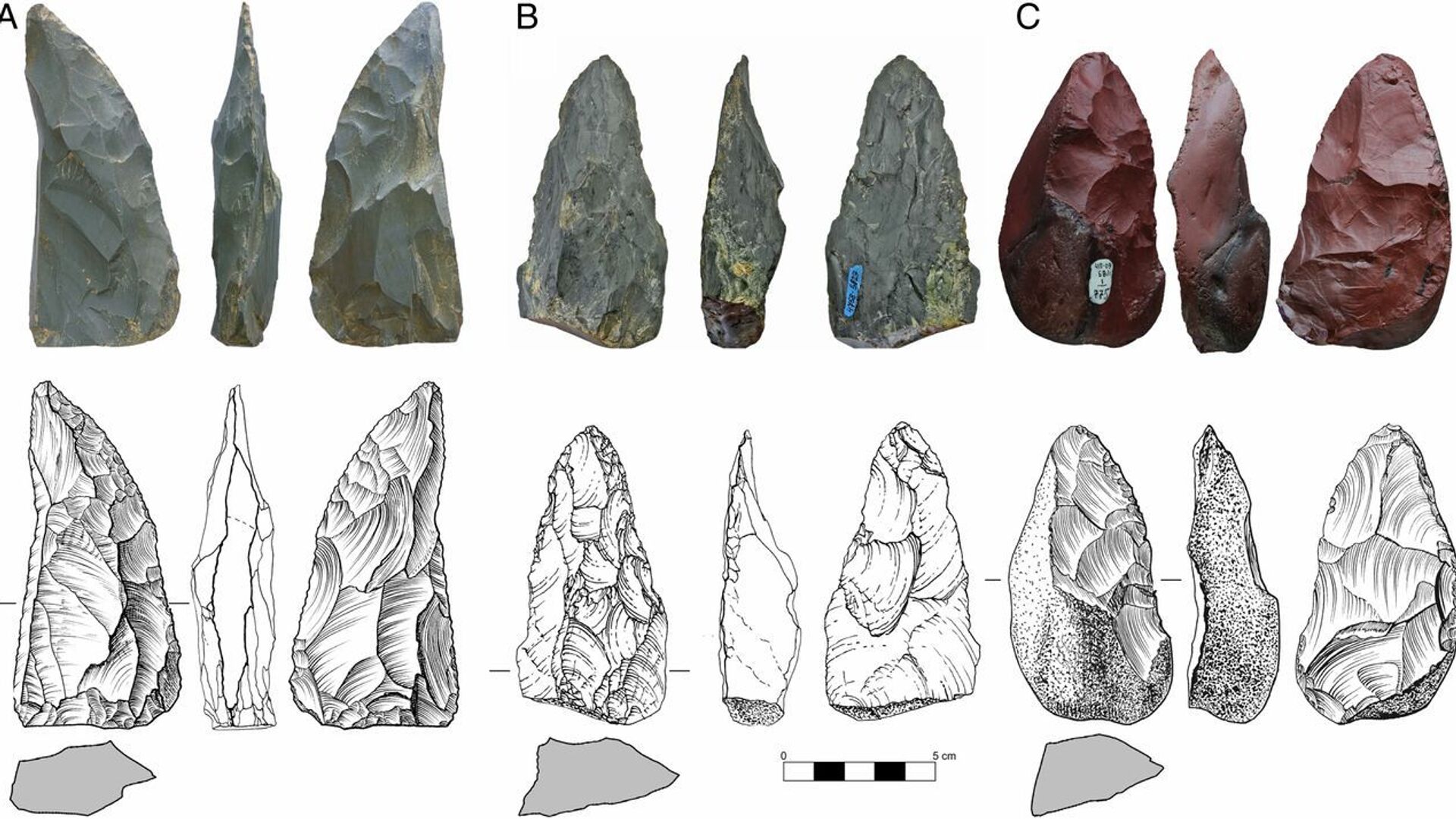https://sputnikglobe.com/20240208/researchers-unveil-the-origin-of-stone-age-technological-advancement--1116660516.html
Researchers Unveil the Origin of Stone Age Technological Advancement
Researchers Unveil the Origin of Stone Age Technological Advancement
Sputnik International
Scientists shed light into how primitive people produced advanced stone tools 50 thousand years ago, cutting across six cultural periods in human history.
2024-02-08T13:55+0000
2024-02-08T13:55+0000
2024-02-08T13:55+0000
beyond politics
nagoya university
eurasia
japan
science & tech
society
newsfeed
https://cdn1.img.sputnikglobe.com/img/107817/06/1078170654_6:0:1275:714_1920x0_80_0_0_ca7f327307c9b86d498d699404822663.jpg
Researchers from Nagoya University Japan have revealed when Stone-Age technological progress began.The team have defined the moment when prehistoric people became sophisticated toolmakers. They examined how our ancestors crafted advanced stone tools over a period of 50,000 years, straddling six cultural eras.Findings published in the journal Nature Communications suggest that the increase in inventiveness and productivity of primitive humans only began with the spread of Homo sapiens across Eurasia.That coincides with the advancement of small stone blade technology during the early Upper Old Stone Age period or Early Upper Paleolithic.The scientists explored how stone tools changed between the Middle to the Upper Paleolithic periods by counting the number of sharp edges on implements unearthed by palaeontologists. The team picked eight groups of tools from five places in southern Jordan with similar environments and available stone for toolmaking. The study found a significant upswing in producing innovative tools did not correspond with the Middle and Upper Palaeolithic eras, when primitive people started using more blades in the Initial Upper Palaeolithic period. Rather, it occurred later when bladelet technology developed in the Early Upper Palaeolithic years.The Japanese team believe their findings partially refute the common theory that early humans overtook Neanderthals and conquered swathes of land thanks to their more-advanced culture and stone tool technology. They posit that these advances only came as our ancestors explored new lands and adapted to their environments over time.
https://sputnikglobe.com/20240124/prehistoric-chewing-gum-reveals-diet-and-poor-oral-health-in-stone-age-teens-1116353024.html
eurasia
japan
Sputnik International
feedback@sputniknews.com
+74956456601
MIA „Rossiya Segodnya“
2024
Chimauchem Nwosu
https://cdn1.img.sputnikglobe.com/img/07e7/09/01/1113046371_0:99:1536:1635_100x100_80_0_0_9c5c627283eca931c39fe4852bbb301c.jpg
Chimauchem Nwosu
https://cdn1.img.sputnikglobe.com/img/07e7/09/01/1113046371_0:99:1536:1635_100x100_80_0_0_9c5c627283eca931c39fe4852bbb301c.jpg
News
en_EN
Sputnik International
feedback@sputniknews.com
+74956456601
MIA „Rossiya Segodnya“
Sputnik International
feedback@sputniknews.com
+74956456601
MIA „Rossiya Segodnya“
Chimauchem Nwosu
https://cdn1.img.sputnikglobe.com/img/07e7/09/01/1113046371_0:99:1536:1635_100x100_80_0_0_9c5c627283eca931c39fe4852bbb301c.jpg
primitive people, stone age, homo sapiens, eurasia, neanderthals, old stone age period, stone tools.
primitive people, stone age, homo sapiens, eurasia, neanderthals, old stone age period, stone tools.
Researchers Unveil the Origin of Stone Age Technological Advancement
Scientists shed light into how primitive people produced advanced stone tools 50 thousand years ago, cutting across six cultural periods in human history.
Researchers from Nagoya University Japan have revealed when Stone-Age technological progress began.
The team have defined the moment when prehistoric people became sophisticated toolmakers. They examined how our ancestors crafted advanced stone tools over a period of 50,000 years, straddling six cultural eras.
Findings published in the journal Nature Communications suggest that the increase in inventiveness and productivity of primitive humans only began with the spread of Homo sapiens across Eurasia.
That coincides with the advancement of small stone blade technology during the early Upper Old Stone Age period or Early Upper Paleolithic.

24 January 2024, 12:19 GMT
The scientists explored how stone tools changed between the Middle to the Upper Paleolithic periods by counting the number of sharp edges on implements unearthed by palaeontologists. The team picked eight groups of tools from five places in southern Jordan with similar environments and available stone for toolmaking.
The study found a significant upswing in producing innovative tools did not correspond with the Middle and Upper Palaeolithic eras, when primitive people started using more blades in the Initial Upper Palaeolithic period. Rather, it occurred later when bladelet technology developed in the Early Upper Palaeolithic years.
The Japanese team believe their findings partially refute the common theory that early humans overtook Neanderthals and conquered swathes of land thanks to their more-advanced culture and stone tool technology. They posit that these advances only came as our ancestors explored new lands and adapted to their environments over time.




